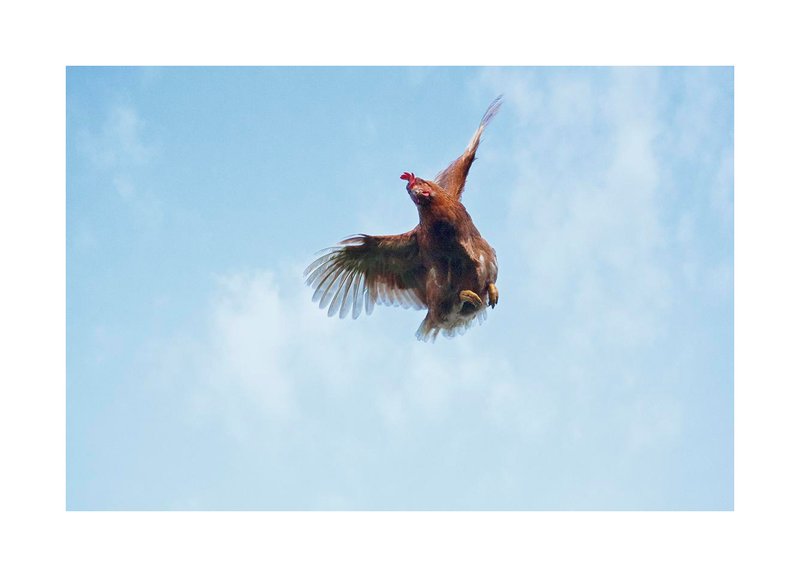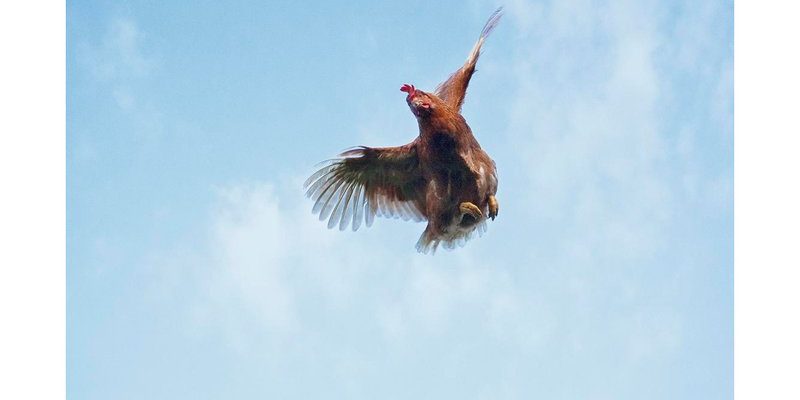
Imagine a small, plump bird making a sudden leap into the air, flapping its wings furiously, and then gliding down to snag a tantalizing bug. This isn’t just a charming sight; it’s a demonstration of survival instincts born out of millions of years of evolution. Let’s dig deeper into the incredible flying and hunting techniques of the chicken, a subject that might surprise you.
How Chickens Fly: It’s Not Just for Show
You might be surprised to know that chickens can actually fly, even if it’s not what you’d call graceful. In fact, chickens can reach heights of about 6 to 8 feet when they take off. This short burst of flight is usually more of a quick escape than an elegant aerial ballet. The structure of their wings plays a significant role in their limited flying ability. Chickens have a unique arrangement of feathers and muscle that enables them to flap and gain a little lift, allowing them to escape predators or reach a safe perch.
When chickens take flight, they rely on their strong breast muscles to propel themselves upward. However, their body weight and wing size also limit how long they can stay airborne. This means that when you see a chicken hop up onto a fence or a low branch, it’s putting its flying skills into action, using a combination of strength and instinct. You might think of it as like a sprinter leaping over a hurdle—quick and efficient but not meant for a marathon.
The Role of Wing Shape and Size
The shape and size of a chicken’s wings are specifically designed for short bursts of flight. Unlike birds that soar gracefully for long distances, chickens have broad, powerful wings that help them take off quickly but don’t lend themselves to long gliding sessions. This is perfect for their lifestyle. Chickens are more ground-dwelling creatures, and their flying serves specific purposes, such as escaping danger or reaching a higher vantage point to check their surroundings.
You might be wondering why chickens don’t fly like other birds. Well, their weight, coupled with a compact body structure, is perfectly adapted for life on the ground. Think of it this way: while a chicken might be able to jump high, it’s not designed for long-distance travel in the sky, keeping it grounded for the most part.
Hunting Techniques: The Chicken as an Unlikely Predator
It’s easy to overlook that chickens are also *predators* of sorts. While they’re often seen as prey, they possess some fascinating hunting techniques that keep them fed. Chickens primarily hunt insects, seeds, and small plants. They use their keen eyesight to spot food sources and then employ a mix of skill and strategy to catch their meals.
When foraging, chickens use a method called “scratching.” They scratch at the ground with their feet, uncovering insects, seeds, and other tasty treats hidden beneath the surface. This behavior is not just instinctual but also a learned skill. Young chicks observe older hens and mimic their movements, which helps them become more effective foragers as they grow.
How Chickens Use Their Beaks and Claws
A chicken’s beak is another essential tool in its hunting arsenal. While it might look small, it’s incredibly effective for picking up food. The beak is designed for pecking and tearing, allowing chickens to grab their prey quickly. With a quick snap, they can catch an unsuspecting bug or pull seeds from the dirt.
Here’s where their claws come into play. Chickens have strong, curved toes that help them dig and scratch the ground effectively. The combination of beak and claws allows chickens to be successful little hunters despite their seemingly docile nature. What’s cool is how they adapt these skills based on their surroundings. In areas with different food sources, chickens can quickly learn new techniques to find food.
The Social Aspect of Hunting
Chickens are social animals and often hunt in groups. This teamwork can be pretty fascinating. When foraging together, chickens can cover more ground and increase their chances of finding food. They communicate with each other using a variety of sounds, alerting their flock members to the presence of food or potential danger.
Interestingly, the pecking order comes into play during foraging. You might see more dominant hens feasting first, while more timid ones wait their turn. This behavior shows how social interactions influence their hunting success and feeding patterns.
Chickens and Their Natural Predators
To truly appreciate chickens as hunters, it’s essential to recognize their position in the food chain. While they might be hunting insects, they also have their own predators to contend with, such as hawks, foxes, and raccoons. This constant threat from above and around shapes their behaviors significantly.
When hunting, chickens remain vigilant, always scanning for potential dangers. Their flying abilities, even if limited, provide them a way to escape. For instance, when a hawk swoops in, a quick flap of their wings and a jump can give them the chance to take cover. This instinct for survival is deeply ingrained and showcases the resilience of chickens as both prey and opportunistic hunters.
Why Understanding Chickens Matters
Understanding the unique flying and hunting techniques of chickens not only sheds light on their abilities but also helps us appreciate these birds more. Whether you’re raising chickens for eggs, meat, or simply as pets, knowing how they function in their ecosystem can enrich your experience and care for them.
Observing your chickens can be rewarding. You might notice how they forage differently depending on the season or how they interact with each other during their hunting escapades. This knowledge can lead to better chicken care and even improve their living conditions, ensuring their needs are met.
Applications in Chicken Husbandry
For those interested in chicken husbandry, understanding their instincts and behaviors is crucial. Providing a space that allows them to exhibit their natural foraging behaviors will not only keep them happy but also healthy. This includes offering them an ample area to scratch around and hunt for insects, which is beneficial for their diet.
Additionally, knowing their social dynamics can help you better manage your flock. Ensuring that there’s enough space and food resources will minimize conflict and create a more harmonious environment for your chickens.
Final Thoughts: Celebrate the Chicken!
Chickens may seem ordinary, but their unique flying and hunting techniques reveal a complexity that’s often overlooked. From their surprisingly effective but short flights to their clever foraging skills, these birds are much more than just backyard pets. They embody a rich history of evolution and adaptability that speaks to the heart of nature’s design.
So, the next time you see a chicken flapping its wings or scratching at the ground, take a moment to appreciate the incredible journey it undertakes every day. After all, every little act of those plucky birds is a reminder of the interconnectedness of life and the beautiful ways animals have adapted to thrive.

